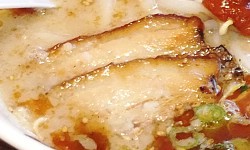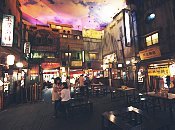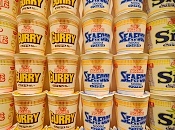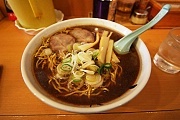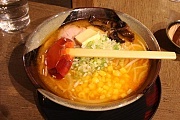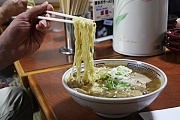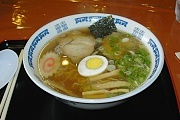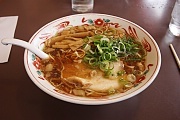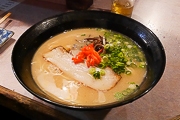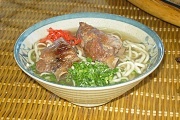Ramen
Ramen (ラーメン) is a noodle soup dish that was originally imported from China and has become one of the most popular dishes in Japan in recent decades. Ramen are inexpensive and widely available, two factors that also make them an ideal option for budget travelers. Ramen restaurants, or ramen-ya, can be found in virtually every corner of the country and produce countless regional variations of this common noodle dish.
Popular ramen types
Ramen are typically categorized according to their soup base, although variations that combine the different bases are not uncommon. The main types of soup are:
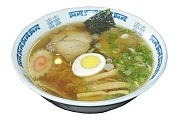
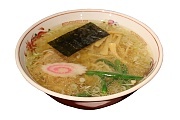
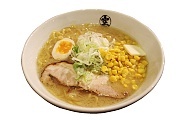
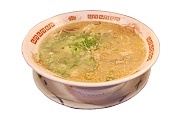
Ramen noodles
The second key aspect of ramen are the noodles, which are made of wheat and come in many different types. Typical ramen noodles are long and elastic, but countless varieties exist that vary from thin and straight to thick and wavy. Some ramen-ya allow you to customize your noodle order to some extent such as by allowing you to select a thickness (thin, regular or thick) or doneness (regular or firm).
Toppings
Below is a list of toppings that are commonly served with ramen:
- Chashu
![]()
Fatty slices of roasted or braised pork. Chashu is a very common topping, and standard bowls of ramen usually come with one or two slices of it. Most ramen-ya also serve Chashumen (chashu ramen) which is a ramen dish with additional pieces of chashu. Kakuni (braised pork belly) is served instead of chashu at some restaurants. - Menma
Preserved bamboo shoots with a salty flavor - Negi
Chopped or shredded leeks or green onions. Karanegi is a spicy variation of shredded leeks mixed with chili oil. Negi is a ramen standard, while karanegi is often seen with miso ramen. - Moyashi
Raw or cooked bean sprouts add sweetness and crunch. Served on all types of ramen. - Tamago
Hard boiled, soft boiled, raw and marinated eggs are all popular toppings on any type of ramen. - Seaweed
Various types of seaweed such as wakame and nori are commonly added to all types of ramen. - Kamaboko
Slices of steamed fish cake. One type of kamaboko that is commonly served on ramen is naruto (or narutomaki), a sawtooth edged, white fish cake with a pink spiral design on it. - Corn
Canned corn is often paired with butter and served on miso or shio ramen. - Butter
A thick pat of butter adds creaminess and depth. Typically added to miso or shio ramen.


Side dishes
Though ramen can be considered a one dish meal, many ramen-ya also serve a selection of side dishes in addition to their noodles. The offerings vary from shop to shop but virtually all ramen-ya serve gyoza (potstickers). These Chinese-style, pan fried dumplings come five or six to an order and are eaten after being dipped in a mixture of soy sauce, vinegar and rayu (hot chili oil), all of which are usually available on the table and combined according to your taste. And of course, nothing complements a steaming hot bowl of ramen like an ice cold beer.
Some shops also offer set deals that include ramen, gyoza and sometimes other dishes such as fried rice or drinks. These sets are sometimes sold at a slightly discounted price compared to ordering everything separately.

Where to find ramen
The best place to eat ramen is at specialized ramen restaurants, the aforementioned ramen-ya, which are commonly found around busy locations such as train stations, entertainment districts and along busy roads. Ramen-ya are usually sit-down restaurants with a counter and some tables, although smaller ones may only have a single counter. In busier locations, some ramen-ya may only offer standing counter space.
Ramen are also often featured on the menus of other restaurants that serve a wider range of dishes such as common eateries found at tourist sites, izakaya, family restaurants and food stalls. Hot ramen dishes can also be purchased around the clock at convenience stores and at some vending machines.
How to order
Typical ramen-ya tend to follow the procedures described on our dining out page, with the additional note that it is fairly common for ramen-ya to use the vending machine method for ordering and paying. In these cases you should purchase meal tickets at the machine near the entrance before being seated.

How to eat
Ramen are eaten with chopsticks which are usually available at the table. A Chinese-style spoon is often provided as well to help with small toppings and for drinking the soup. It is also alright to lift up the bowl to drink the soup directly from the bowl.
Ramen noodles get soggy quickly and should be eaten immediately after they are served. As with other noodle dishes in Japan, a slurping sound is made when eating ramen. The slurping enhances the flavors and helps cool down the piping hot noodles as they enter your mouth. At the end of the meal, it is alright to leave some unfinished soup in the bowl. You do not need to drink the whole bowl to be polite, although it is considered a compliment to the chef to do so.

Ramen-related attractions
Regional varieties
Ramen are also available in many regional varieties, some of which have become so popular that they are now found nationwide. A few of the best known regional varieties are:
Instant ramen
Ramen are also available in several prepared forms that are quick and easy to make at home or in your hotel room. A wide range of instant ramen products are sold in cups and packets at supermarket, convenience store and some vending machines. The simplest require only the addition of hot water, which is sometimes supplied at the store or machine where they are sold. Hotels in Japan almost always provide a hot water pot on their rooms, making these types of instant ramen an easy, hot meal choice for tourists, as well.
There are also various types of fresh ramen and ramen toppings sold at Japanese grocery stores. These are fast and easy to make too, but require a little more time to prepare than the instant varieties as the noodles do not come precooked. In addition to boiling the noodles, you must also make the soup from the concentrated soup base included with the noodles and your desired toppings. Despite this extra bit of effort, these products make it possible to enjoy restaurant quality ramen conveniently at your own home.

Questions? Ask in our forum.
